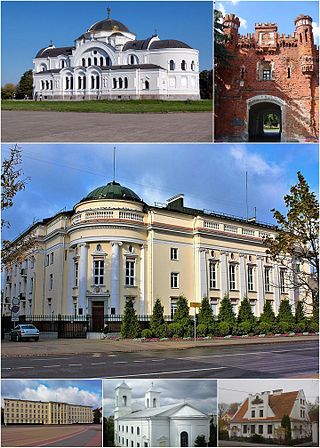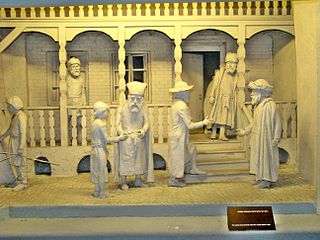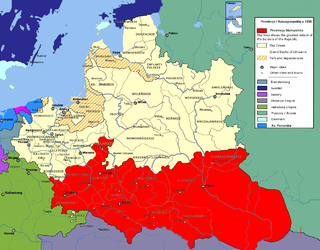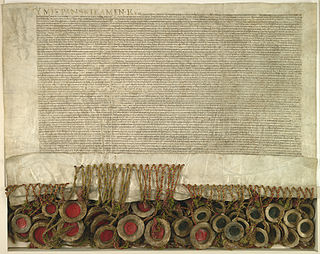Lublin is a city in Poland.
Contents
Lublin may also refer to:
Lublin is a city in Poland.
Lublin may also refer to:

Lesser Poland, often known by its Polish name Małopolska, is a historical region situated in southern and south-eastern Poland. Its capital and largest city is Kraków. Throughout centuries, Lesser Poland developed a separate culture featuring diverse architecture, folk costumes, dances, cuisine, traditions and a rare Lesser Polish dialect. The region is rich in historical landmarks, monuments, castles, natural scenery and UNESCO World Heritage Sites.

Lublin is the ninth-largest city in Poland and the second-largest city of historical Lesser Poland. It is the capital and the centre of Lublin Voivodeship with a population of 336,339. Lublin is the largest Polish city east of the Vistula River and is about 170 km (106 mi) to the southeast of Warsaw by road.

Brest, formerly Brest-Litovsk and Brest-on-the-Bug, is a city in Belarus at the border with Poland opposite the Polish town of Terespol, where the Bug and Mukhavets rivers meet, making it a border town. It serves as the administrative center of Brest Region and Brest District, though it is administratively separated from the district. As of 2023, it has a population of 342,461.

Lubartów is a town in eastern Poland, with 23,000 inhabitants (2004), situated in Lublin Voivodeship. It is the capital of Lubartów County and the Lubartów Commune. Historically it belongs to Lesser Poland.

Radzyń Podlaskipronounced[ˈrad͡zɨɲpɔdˈlaskʲi] is a town in eastern Poland, about 60 km north of Lublin, with 15,808 inhabitants (2017). Situated in the Lublin Voivodeship since 1999, previously it was part of the Biała Podlaska Voivodeship (1975–1998). It is the capital of Radzyń Podlaski County, and historically belongs to the region of Lesser Poland. The town was founded in 1468, and its most important landmark is the rococo Potocki Palace.

Parczew is a town in eastern Poland, with a population of 10,281 (2006). It is the capital of Parczew County in the Lublin Voivodeship.

Chełm is a city in southeastern Poland with 60,231 inhabitants as of December 2021. It is located to the south-east of Lublin, north of Zamość and south of Biała Podlaska, some 25 kilometres from the border with Ukraine. Chełm used to be the capital of the Chełm Voivodeship until it became part of the Lublin Voivodeship in 1999.

The Council of Four Lands was the central body of Jewish authority in the Polish–Lithuanian Commonwealth from the second half of the 16th century to 1764, located in Lublin. The Council's first law is recorded as having been passed in 1580. Seventy delegates from local kehillot met to discuss taxation and other issues important to the Jewish community. The "four lands" were Greater Poland, Little Poland, Galicia and Volhynia. The earliest form of the Council was organized in 1514 by Sigismund I the Old and Abraham of Bohemia was put in charge of it.

Poniatowa is a town in southeastern Poland, in Opole Lubelskie County, in Lublin Voivodship, with 10,500 inhabitants (2006). It belongs to the historic province of Lesser Poland. During the existence of the 17th-century Polish–Lithuanian Commonwealth Poniatowa was part of the Lublin Voivodeship also. For most of its history Poniatowa was a village; it did not receive town charter until July 18, 1962. The town has a sports club Stal, established in 1951.

Bratslav is an urban-type settlement in Ukraine, located in Tulchyn Raion of Vinnytsia Oblast, by the Southern Bug river. It is a medieval European city and a regional center of the Eastern Podolia region founded by government of the Crown of the Kingdom of Poland, which dramatically lost its importance during the 19th-20th centuries. Population: 4,872

Olyka is an urban-type settlement in Lutsk Raion, Volyn Oblast, western Ukraine. It is located east of Lutsk on the Putylivka Rriver. Its population is 3,032.

The history of the Jews in Lithuania spans the period from the 14th century to the present day. There is still a small community in the country, as well as an extensive Lithuanian Jewish diaspora in Israel, the United States and other countries.

The history of the Jews in Belarus begins as early as the 8th century. Jews lived in all parts of the lands of modern Belarus. In 1897, the Jewish population of Belarus reached 910,900, or 14.2% of the total population. Following the Polish-Soviet War (1919-1920), under the terms of the Treaty of Riga, Belarus was split into Eastern Belorussia and Western Belorussia, and causing 350,000-450,000 of the Jews to be governed by Poland. Prior to World War II, Jews were the third largest ethnic group in Belarus and comprised more than 40% of urban population. The population of cities such as Minsk, Pinsk, Mahiliou, Babrujsk, Viciebsk, and Homiel was more than 50% Jewish. In 1926 and 1939 there were between 375,000 and 407,000 Jews in Belarus or 6.7-8.2% of the total population. Following the Soviet annexation of Eastern Poland in 1939, including Western Belorussia, Belarus would again have 1,175,000 Jews within its borders, including 275,000 Jews from Poland, Ukraine, and elsewhere. It is estimated 800,000 of 900,000 — 90% of the Jews of Belarus —were killed during the Holocaust. According to the 2019 Belarusian census, there were 13,705 self-identifying Jews in Belarus, of which most are of Ashkenazi origin. However, the Israeli embassy in Belarus claims to know about 30-50 thousand Belarusians with Jewish descent.

The history of the Jews in Europe spans a period of over two thousand years. Some Jews, a Judaean tribe from the Levant, migrated to Europe just before the rise of the Roman Empire. Although Alexandrian Jews had already migrated to Rome, a notable early event in the history of the Jews in the Roman Empire was the 63 BCE siege of Jerusalem.

Polonia, the name for Poland in Latin and many Romance and other languages, is most often used in modern Polish as referring to the Polish diaspora. However, as can be seen from the image, it was also used as a national personification.
The Ruthenian nobility originated in the territories of Kievan Rus' and Galicia–Volhynia, which were incorporated into the Grand Duchy of Lithuania, Polish–Lithuanian Commonwealth and later the Russian and Austrian Empires. The Ruthenian nobility became increasingly polonized and later russified, while retaining a separate cultural identity.

Goraj is a town in Biłgoraj County, Lublin Voivodeship, in eastern Poland. It is the seat of the gmina called Gmina Goraj. It lies in historic Lesser Poland, approximately 20 kilometres (12 mi) north of Biłgoraj and 60 km (37 mi) south of the regional capital Lublin. The town has a population of 1,048. It was granted town rights in the 14th century, lost them in 1869 and was granted them again in 2021.

Lesser Poland Province was an administrative division of the Crown of the Kingdom of Poland from 1569 until 1795 and the biggest province of the Polish–Lithuanian Commonwealth. The name of the province comes from historic land of Lesser Poland. The name of the province did not imply its size, but rather seniority.

The Union of Lublin was signed on 1 July 1569 in Lublin, Poland, and created a single state, the Polish–Lithuanian Commonwealth, one of the largest countries in Europe at the time. It replaced the personal union of the Crown of the Kingdom of Poland and the Grand Duchy of Lithuania with a real union and an elective monarchy, as Sigismund II Augustus, the last of the Jagiellons, remained childless after three marriages. In addition, the autonomy of Royal Prussia was largely abandoned. The Duchy of Livonia, tied to Lithuania in real union since the Union of Grodno (1566), became a Polish–Lithuanian condominium.

The expression 'Eastern European Jewry' has two meanings. Its first meaning refers to the current political spheres of the Eastern European countries and its second meaning refers to the Jewish communities in Russia and Poland. The phrase 'Eastern European Jews' or 'Jews of the East' was established during the 20th century in the German Empire and in the western provinces of the Austro-Hungarian Empire, aiming to distinguish the integrating Jews in Central Europe from those Jews who lived in the East. This feature deals with the second meaning of the concept of Eastern European Jewry- the Jewish groups that lived in Poland, Ukraine, Belarus, Latvia, Lithuania, Estonia, Russia, Romania, Hungary and modern-day Moldova in collective settlement. Many of whom spoke Yiddish.